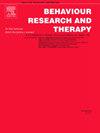通过对无条件刺激的心理想象,利用偶发强化消退来优化消退学习
IF 4.2
2区 心理学
Q1 PSYCHOLOGY, CLINICAL
引用次数: 0
摘要
在消退训练(偶发强化消退,ORE)过程中,偶尔出现非条件刺激(US),无论是不与条件刺激(CS)配对还是与条件刺激(CS)配对,都能提供初步证据,证明恐惧的恢复不那么明显。然而,将这种方法转化为临床实践具有挑战性,因为要让患者接触到原始的 USs,在伦理和实践方面都存在顾虑。本研究采用一种新颖的方法,即利用生动的 US 恐惧想象而不是实际暴露于 US,来研究 ORE 对恐惧反应的消减。三个实验组接受了不同的恐惧条件反射。随后,参与者分别接受非强化(标准消退,N = 25)、偶尔配对(N = 26)或偶尔不配对(N = 25)的强化消退训练,然后对恐惧反应的自发恢复、恢复和重新获得进行评估。在自发恢复、恢复和重新获得过程中的反应模式显示,配对或非配对的想象性诱发反应训练均无益处。目前的研究结果表明,将对美国的恐惧想象纳入定向障碍康复训练至今并不能减少恐惧的恢复。我们还需要进一步研究,以确定经过调整的想象性 ORE 是否仍然是将 ORE 方法转化为临床实践的一种适用策略。本文章由计算机程序翻译,如有差异,请以英文原文为准。
Leveraging occasional reinforced extinction via mental imagery of the unconditioned stimulus to optimize extinction learning
Occasionally presenting the unconditioned stimulus (US) during extinction training (occasional reinforced extinction, ORE) either unpaired or paired with the conditioned stimulus (CS) provides initial evidence for a less pronounced return of fear. However, translating this approach into clinical practice is challenging due to ethical and practical concerns of exposing patients to the original USs. The present study investigated extinction of fear responses in a novel approach employing ORE using vivid fear imagery of the US instead of actually exposing to it. Three experimental groups underwent differential fear conditioning. Subsequently, participants either received a non-reinforced (standard extinction, N = 25), occasional paired (N = 26), or occasional unpaired (N = 25) reinforced extinction training, followed by assessments for spontaneous recovery, reinstatement, and reacquisition of fear responses. Response patterns during spontaneous recovery, reinstatement and reacquisition showed no benefit from either paired or unpaired imaginative ORE. The current findings suggest that incorporating fear imagery of the US in ORE so far does not result in reducing the return of fear. Further investigation is needed to determine whether imaginal ORE with adjustments could still be a readily applicable strategy for translating the ORE approach into clinical practice.
求助全文
通过发布文献求助,成功后即可免费获取论文全文。
去求助
来源期刊

Behaviour Research and Therapy
PSYCHOLOGY, CLINICAL-
CiteScore
7.50
自引率
7.30%
发文量
148
期刊介绍:
The major focus of Behaviour Research and Therapy is an experimental psychopathology approach to understanding emotional and behavioral disorders and their prevention and treatment, using cognitive, behavioral, and psychophysiological (including neural) methods and models. This includes laboratory-based experimental studies with healthy, at risk and subclinical individuals that inform clinical application as well as studies with clinically severe samples. The following types of submissions are encouraged: theoretical reviews of mechanisms that contribute to psychopathology and that offer new treatment targets; tests of novel, mechanistically focused psychological interventions, especially ones that include theory-driven or experimentally-derived predictors, moderators and mediators; and innovations in dissemination and implementation of evidence-based practices into clinical practice in psychology and associated fields, especially those that target underlying mechanisms or focus on novel approaches to treatment delivery. In addition to traditional psychological disorders, the scope of the journal includes behavioural medicine (e.g., chronic pain). The journal will not consider manuscripts dealing primarily with measurement, psychometric analyses, and personality assessment.
 求助内容:
求助内容: 应助结果提醒方式:
应助结果提醒方式:


